21.76.050 Permit Types and Procedures.
A. Purpose. The purpose of this chapter is to provide detailed administrative review procedures for applications and land use permits classified as Types I through VI.
B. Scope. Land use and development decisions are classified into six processes based on who makes the decision, the amount of discretion exercised by the decision maker, the level of impact associated with the decision, the amount and type of input sought, and the type of appeal opportunity generally as follows:
|
Table 21.76.050A |
||||||
|---|---|---|---|---|---|---|
|
Permit Type |
||||||
|
Type I Administrative |
Type II Administrative |
Type III Quasi-Judicial |
Type IV Quasi-Judicial |
Type V Quasi-Judicial |
Type VI Legislative |
|
|
Level of Impact and Level of Discretion Exercised by decision maker |
Least level of impact or change to policy/regulation. Least level of discretion. |

|
Potential for greatest level of impact due to changes in regulation or policy. Greatest level of discretion. |
|||
|
Input Sought |
Minimal-generally no public notice required. No public hearing. |
Notice of Application provided. No public hearing. Neighborhood meeting only required for short plats meeting certain criteria. |
Notice of Application provided. Neighborhood meeting may be required. Public hearing is required. |
Notice of Application provided. Neighborhood meeting may be required. Public hearing is required. |
Notice of Application provided. Neighborhood meeting may be required. Public hearing is required. |
Notice of Public Hearing provided. |
|
Public Hearing prior to Decision? |
No |
No |
Yes, Hearing Examiner (or Landmarks Commission)2 |
Yes, Hearing Examiner |
Yes, City Council |
Yes, Planning Commission |
|
Decision Maker |
Appropriate Department |
Hearing Examiner (or Landmarks Commission)2 |
City Council |
City Council |
City Council |
|
|
Administrative Appeal Body |
Hearing Examiner (Hearing Examiner decision on appeal may be appealed to Superior Court.) |
Hearing Examiner1(Hearing Examiner decision on appeal may be appealed to Superior Court.) |
None (decision appealable to Superior Court)1 |
None (decision appealable to Superior Court) |
None (decision appealable to Superior Court) |
None (decision appealable to Superior Court) |
|
Hearing Examiner3 (Hearing Examiner decision appealable to Superior Court) |
||||||
|
TABLE NOTES: 1. Shoreline Substantial Development Permits, Shoreline Variances, and Shoreline Conditional Use Permits are appealable directly to the State Shorelines Hearings Board. Use Permits are appealable directly to the State Shorelines Hearings Board. 2. Landmarks Commission makes decisions for Certificate of Appropriateness Level III permits. 3. Only for decision by Landmarks Commission |
||||||
C. Classification of Permits and Decisions - Table. The following table sets forth the various applications required and classifies each application by the process used to review and decide the application.
|
Type I - RZC 21.76.050.F: |
Administrative Approval, Appropriate Department is Decision Maker |
|
Type II - RZC 21.76.050.G: |
Administrative Approval, Review and Decision by Technical Committee and Design Review Board or Landmarks Commission* |
|
Type III - RZC 21.76.050.H: |
Quasi-Judicial, Decision by Hearing Examiner or Landmarks and Heritage Commission* |
|
Type IV - RZC 21.76.050.I: |
Quasi-Judicial, Recommendation by Hearing Examiner, Decision by City Council |
|
Type V - RZC 21.76.050.J: |
Quasi-Judicial, Decision by City Council |
|
Type VI - RZC 21.76.050.K: |
Legislative, recommendation by Planning Commission, Decision by City Council |
|
*for properties with a Designation of Historic Significance, please refer to RZC 21.76.060.H, Landmarks and Heritage Commission Determination/Decisions. |
|
|
Table 21.76.050B |
||
|---|---|---|
|
Permit Type |
Process Type |
RMC Section (if applicable) |
|
Administrative Interpretation |
I |
|
|
Administrative Modification |
II |
|
|
Alteration of Geologic Hazard Areas |
III |
|
|
II |
||
|
I |
||
|
I |
RMC 15.06 |
|
|
Certificate of Appropriateness Level I |
I |
|
|
Certificate of Appropriateness Level II |
II |
|
|
Certificate of Appropriateness Level III |
III |
|
|
Clearing and Grading Permit |
I |
RMC 15.24 |
|
Comprehensive Plan Map and/or Policy Amendment |
VI |
|
|
Conditional Use Permit |
III |
|
|
Development Agreement |
V |
|
|
Electrical Permit |
I |
RMC 15.12 |
|
IV |
||
|
Extended Public Area Use Permit |
I |
RMC 12.08 |
|
Flood Zone Permit |
I |
RMC 15.04 |
|
Historic Landmark Designation |
III |
|
|
I |
||
|
Hydrant Use Permit |
I |
RMC 13.16.020 |
|
International Fire Code Permit |
I |
RMC 15.06 |
|
II, III, IV or V |
||
|
Mechanical Permit |
I |
RMC 15.14 |
|
Plat Alteration |
V |
|
|
Plat Vacation |
V |
|
|
Plumbing Permit |
I |
RMC 15.16 |
|
III |
||
|
Reasonable Use Exception See RZC 21.76.070.U |
I,II, III, IV or V |
|
|
Right-of-Way Use Permit |
I |
RMC 12.08 |
|
Sewer Permit |
I |
RMC 13.04 |
|
Permit Type |
Process Type |
RMC Section (if applicable) |
|
Shoreline Conditional Use Permit |
III |
|
|
Shoreline Exemption |
I |
|
|
Shoreline Substantial Development Permit |
II |
|
|
III |
||
|
II |
||
|
Sign Permit/Program |
I |
|
|
Site Plan Entitlement |
II |
|
|
Special Event Permit |
I |
RMC 10.60 |
|
Structure Movement Permit I-IV |
I |
RMC 15.22 |
|
Temporary Use Permit (Long-Term) |
V |
|
|
Temporary Use Permit (Short-Term) |
I |
|
|
I |
||
|
III |
||
|
Water Permit |
I |
RMC 13.08 |
|
Willows Rose Hill Demonstration Project |
III |
|
|
I |
||
|
II |
||
|
Zoning Code Amendment-Zoning Map (consistent with Comprehensive Plan) |
IV |
|
|
Zoning Code Amendment (text) |
VI |
|
|
Zoning Code Amendment (that requires a Comprehensive Plan Amendment) |
VI |
|
D. Permits and Actions Not Listed. If a permit or land use action is not listed in the table in RZC 21.76.050.C, Classification of Permits and Decisions, the Administrator shall make a determination as to the appropriate review procedure based on the most analogous permit or land use action listed.
E. Consolidated Permit and Appeal Process.
1. Where this Code requires more than one land use permit for a given development, all permit applications (except Type I applications) may be submitted for review collectively according to the consolidated review process established by this section.
2. Where two or more land use applications for a given development are submitted for consolidated review, the review shall be conducted using the highest numbered process type applicable to any of the land use applications, provided that each land use application shall only be subject to the relevant decision criteria applicable to that particular development application. For example, a development proposal that includes a Type II application and a Type III application shall be reviewed using the Type III process, but the Type II application shall be decided based on the relevant decision criteria applicable to the Type II application. If two or more land use applications are consolidated for review, the highest application review and decision timeframe as outlined within RZC 21.76.040.D shall apply.
3. When the consolidated process established by this section is used, the City shall issue single, consolidated notices, staff reports, and decision documents encompassing all of the land use applications under review. Except as provided in subsection E.5 below, the applications shall be considered in a single, consolidated open record public hearing and shall be subject to no more than one consolidated closed record appeal.
4. Where a development requires more than one land use permit but the applicant elects not to submit all applications for consolidated review, applications may be submitted and processed sequentially, provided that the permit subject to the highest numbered process type must be submitted and obtained first, followed by the other permits in sequence from the highest numbered type to the lowest.
5. Where a development proposal requires a zoning map amendment, the zoning map amendment must be considered and approved by the Hearing Examiner and City Council before any hearing is held or decision is made on any related application for a conditional use permit, subdivision, variance, master planned development, site plan entitlement, or other similar quasi-judicial or administrative action. This subsection is intended to be a “procedural requirement” applicable to such actions as contemplated by RCW 58.17.070.
6. All appeals of project permit decisions for a single project shall be consolidated and heard together in a single appeal, using the highest-level appeals process, except for appeals of environmental Determinations of Significance. Where a Determination of Significance (DS) is appealed, the appeal shall be heard by the Hearing Examiner using the Type II review process prior to any consideration of the underlying application. Where a Determination of Non-Significance (DNS) or the adequacy of an Environmental Impact Statement (EIS) is appealed, the hearing on the appeal shall be consolidated with any open record public hearing to be conducted on the underlying application.
F. Type I Review.
1. Overview of Type I Review. A Type I process is an administrative review and decision by the appropriate department director or designee. These are applications which are categorically exempt from review under the State Environmental Policy Act (SEPA) or permits for which environmental review has been completed in connection with another application. Appeals of Type I decisions are made to the Hearing Examiner in an open record hearing. Appeal decisions of the Hearing Examiner may be appealed to the King County Superior Court. Type I reviews are exempt from the procedures of RZC 21.76.040, Time Frames for Review.
2. Process Flow Chart. The flow chart below in Figure 21.76.050A depicts the process that will be used to review a typical Type I land use permit. The process may vary for individual permits based on the nature and complexity of the issues involved. This flow chart is therefore provided for general reference only. More detail on each of the steps is provided in RZC 21.76.060, Process Steps and Decision Makers.
|
Figure 21.76.050A |
|---|
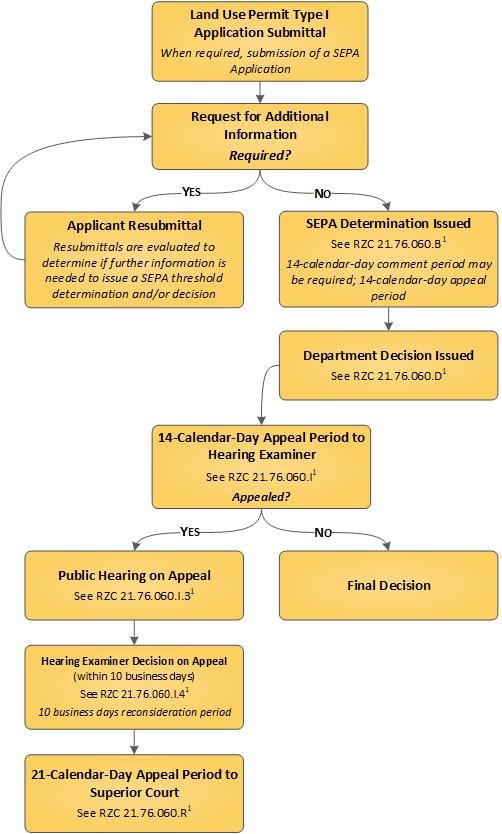
|
|
Figure Notes: 1. Link to RZC 21.76.060 |
G. Type II Review.
1. Overview of Type II Review. A Type II process is an administrative review and decision by the Technical Committee and, when required, by the Design Review Board or the Landmarks and Heritage Commission. Depending on the application, the Technical Committee may require a neighborhood meeting to obtain public input. Except for Certificates of Appropriateness related to historic structures, public notification is provided at the application and decision stages of review. Environmental review is conducted, when required. Appeals of Type II decisions are made to the Hearing Examiner in an open record hearing. Appeal decisions of the Hearing Examiner may be appealed to the King County Superior Court.
2. Process Flow Chart. The flow chart below in Figure 21.76.050B generally depicts the process that will be used to review a typical Type II land use permit. The process may vary for individual permits based on the nature and complexity of the issues involved. This flow chart is therefore provided for general reference only. More detail on each of the steps is provided in RZC 21.76.060, Process Steps and Decision Makers, and RZC 21.76.080, Notices.
|
Figure 21.76.050B |
|---|
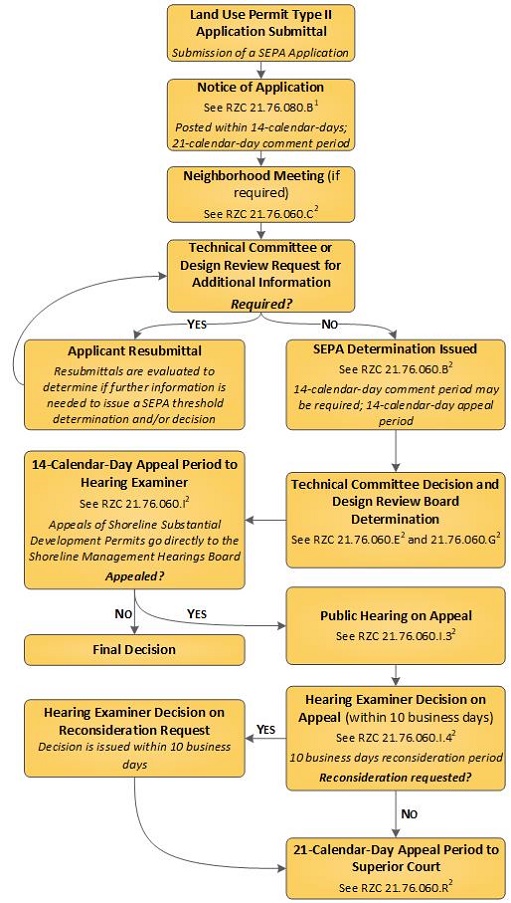
|
|
Figure Notes: 1. Link to RZC 21.76.080 2. Link to RZC 21.76.060 |
H. Type III Review.
1. Overview of Type III Review. A Type III process is a quasi-judicial review and decision made by the Hearing Examiner or, in the case of Level III Certificates of Appropriateness on which a hearing is to be held under 70-090(4)(b) and in the case of Historic Landmark Designations for removal of Historic Landmark Designations, by the Landmarks and Heritage Commission. Environmental review is conducted when required. The Hearing Examiner (or the Landmarks and Heritage Commission on the applications described in the preceding sentence) holds an open record public hearing on a Type III application after receiving a recommendation from the Technical Committee and, when required, the Design Review Board. Depending on the application, the Technical Committee may require a neighborhood meeting to obtain public input. Public notification is provided at the application, public hearing, and decision stages of application review. The Hearing Examiner (or the Landmarks and Heritage Commission on the applications described above) makes a decision after considering the recommendation of the Technical Committee and Design Review Board and the public testimony received at the open record public hearing. Decisions of the Hearing Examiner are appealable to the King County Superior Court, which considers the appeal in a closed record appeal proceeding. Decisions by the Landmarks and Heritage Commission are appealable to the Hearing Examiner, that considers the appeal in a closed record appeal proceeding. The decision of the Hearing Examiner, regarding appeals of a Landmarks and Heritage Commission decision, are appealable to the King County Superior Court, which considers the appeal in a closed record appeal proceeding.
2. Process Flow Chart. The flow chart below in Figure 21.76.050C generally depicts the process that will be used to review a typical Type III land use permit. The process may vary for individual permits based on the nature and complexity of the issues involved. This flow chart is therefore provided for general reference only. More detail on each of the steps is provided in RZC 21.76.060, Process Steps and Decision Makers, and RZC 21.76.080, Notices.
|
Figure 21.76.050C |
|---|
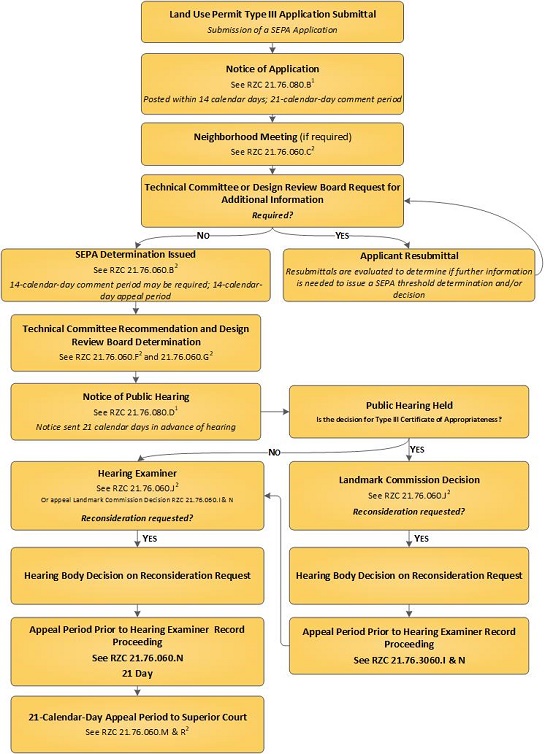
|
|
Figure Notes: 1. Link to RZC 21.76.080 2. Link to RZC 21.76.060 |
I. Type IV Review.
1. Overview of Type IV Review. A Type IV review is a quasi-judicial review and recommendation made by the Hearing Examiner and a decision made by the City Council. Environmental review is conducted when required. At an open record public hearing, the Hearing Examiner considers the recommendation of the Technical Committee and, when required, the Design Review Board, as well as public testimony. Depending on the application, the Technical Committee may require a neighborhood meeting to obtain public input. The Hearing Examiner makes a recommendation to the City Council, which considers the recommendation in a closed record proceeding and makes a final decision. Public notification is provided at the application, public hearing, and decision stages of application review. There is no administrative appeal. The City Council’s decision may be appealed to the King County Superior Court.
2. Process Flow Chart. The flow chart below in Figure 21.76.050D generally depicts the process that will be used to review a typical Type IV land use permit. The process may vary for individual permits based on the nature and complexity of the issues involved. This flow chart is therefore provided for general reference only. More detail on each of the steps is provided in RZC 21.76.060, Process Steps and Decision Makers, and RZC 21.76.080, Notices.
|
Figure 21.76.050D |
|---|
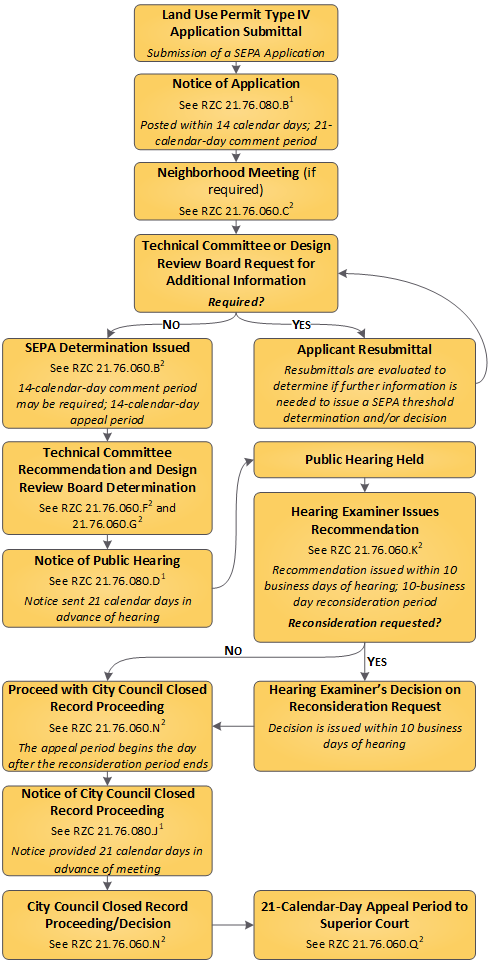
|
|
Figure Notes: 1. Link to RZC 21.76.080 2. Link to RZC 21.76.060 |
J. Type V Review.
1. Overview of Type V Review. A Type V review is a quasi-judicial review and decision made by the City Council. Environmental review is conducted when required. The Technical Committee (and Design Review Board, if required) makes a recommendation to the City Council. Depending on the application, the Technical Committee may require a neighborhood meeting to obtain public input. The City Council shall hold a public hearing on the application prior to making a decision. Public notification is provided at the application, public hearing, and decision stages of application review. There is no opportunity for an administrative appeal. Appeals of City Council decisions are made to King County Superior Court.
2. Process Flow Chart. The flow chart below in Figure 21.76.050E generally depicts the process that will be used to review a typical Type V land use permit. The process may vary for individual permits based on the nature and complexity of the issues involved. This flow chart is therefore provided for general reference only. More detail on each of the steps is provided in RZC 21.76.060, Process Steps and Decision Makers, and RZC 21.76.080, Notices.
|
Figure 21.76.050E |
|---|
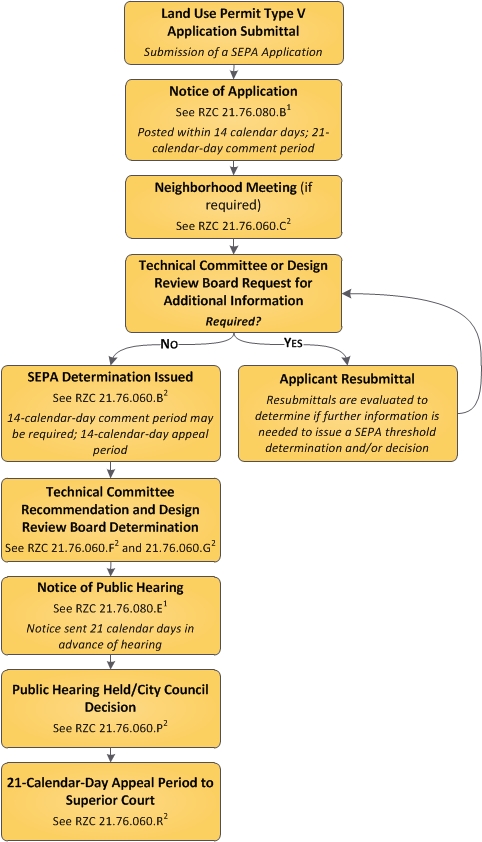
|
|
Figure Notes: 1. Link to RZC 21.76.080 2. Link to RZC 21.76.060 |
K. Type VI Review.
1. Overview of Type VI Review. A Type VI review is for legislative land use decisions made by the City Council under its authority to establish policies and regulations regarding future private and public development and management of public lands. Environmental review is conducted when required. The Planning Commission holds at least one open record public hearing and makes a recommendation to the City Council. The City Council may hold an additional public hearing or hearings at its option. The City Council makes a final decision. The City Council’s decision may be appealed to the Central Puget Sound Growth Management Hearings Board. Type VI reviews are exempt from the procedures of RZC 21.76.040, Time Frames for Review.
2. Process Flow Chart. The flow chart below in Figure 21.76.050F generally depicts the process that will be used to review a typical Type VI land use permit. The process may vary for individual permits based on the nature and complexity of the issues involved. This flow chart is therefore provided for general reference only. More detail on each of the steps is provided in RZC 21.76.060, Process Steps and Decision Makers, and RZC 21.76.080, Notices.
|
Figure 21.76.050F |
|---|
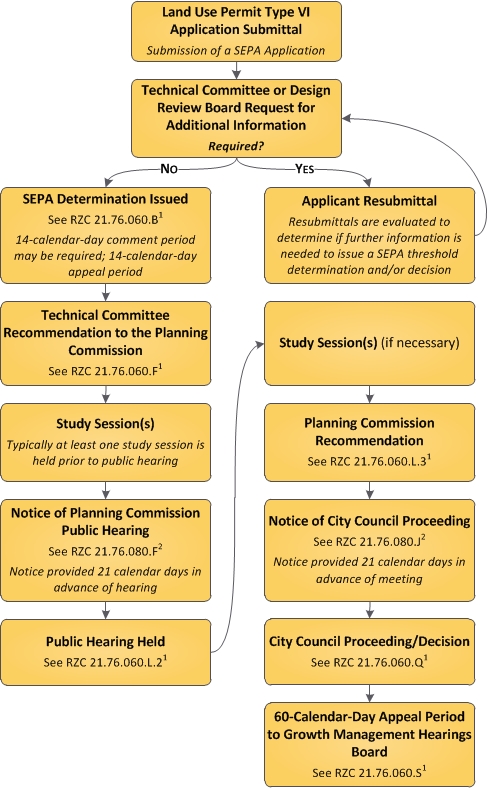
|
|
Figure Notes: 1. Link to RZC 21.76.060 2. Link to RZC 21.76.080 |